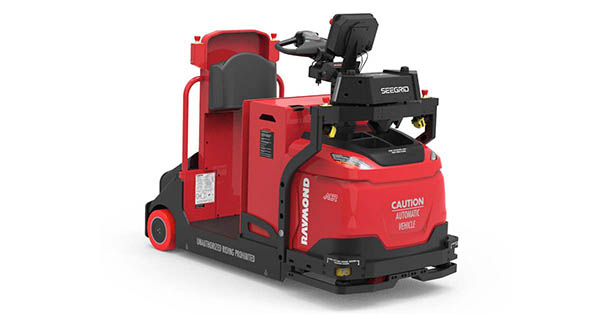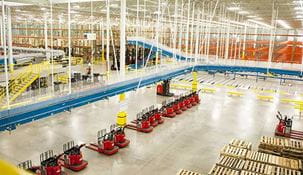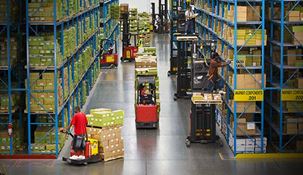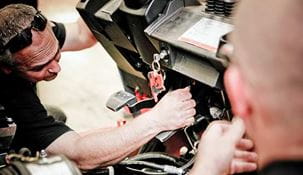-

Savannah Autonomous Guided Vehicle (AGV)
Carolina Handling sells, installs and maintains Autonomous Guided Vehicles (AGVs) and other AS/RS equipment in Georgia and across the Southeast. Our automation specialists can help you find the perfect solution from world class AS/RS manufacturers like Modula.
Georgia Autonomous Guided Vehicle Supplier
What is an AGV?
Sometimes known as self-guided vehicles or autonomous guided vehicles, automated guided vehicles (AGVs) are material handling systems or goods carriers that move autonomously around the ground surfaces of a warehouse, distribution center or production facility without an onboard operator.
What are Automated Guided Vehicles used for?
Standard AGV applications include retrieval and storage in storage facilities and distribution centers, typically in support of order picking. They are similarly put to use for transportation of raw materials, work-in-process and finished goods in factories.
What are the main advantages of Self-Guided Vehicles?
- Decreased Labor Costs: AGVs can considerably lower labor expenses. A one-time expenditure can remove the continuous expenses of wages, taxes and benefits associated with a full-time worker.
- Increased Safety: Modern AGVs utilize sophisticated video cameras, lasers or other sensors that enable them to "see" and react to their surroundings instantaneously. Humans can become careless or distracted, whereas self-guided vehicles do not. AGVs can likewise be utilized in extreme environments or around dangerous materials where personal security is endangered.
- Increased Productivity & Accuracy: AGVs can work around the clock, never needing breaks or tiring. They can make repeated treks around a warehouse quickly. They also do not make the types of errors that humans are prone to making.
- Modularity: Most AGV systems can be implemented gradually, displacing a few workers incrementally without a huge expenditure in advance. As automation needs accelerate, more AGVs can easily be added to the facility.
How do AGVs work?
AGVs are shepherded by a combination of sensor-based management systems and bundled software. They can travel securely through a storage or manufacturing facility by using barrier detection bumpers and following carefully defined routes while using precisely managed acceleration and deceleration.
AGV navigation is typically managed by one of these categories of systems:
- Vision guidance: Cameras log the AGV's environment, and the vehicles utilize these logged images to get around. Vision guidance is standalone, and as a result, no modification is needed to a production facility or warehouse infrastructure for this kind of navigation.
- Laser target navigation: With laser-based equipment, reflective tape is affixed to pallet racks, wall surfaces, poles and other fixed items. AGVs use laser transmitters to rebound laser beams off of these reflectors and then use the range and angle of items to find a path.
- LiDAR: LiDAR solutions transmit laser bursts to determine the distance between the AGV and objects in its vicinity. This information is utilized to establish a 360-degree map of the environment. In similarity to vision guidance, no modification of a building is needed.
- Inertial navigation: Transponders implanted into a building's flooring route AGVs along a defined track.
- Wired navigation: These systems employ wire pathways embedded into a warehouse or factory floor. The wire broadcasts a signal that an AGV recognizes through a sensor or antenna system.
- Magnetic guide tape: This type of AGV uses magnetic sensing units and conforms to a route defined by magnetic tape.
What are the various types of Autonomous Guided Vehicles?
There are several kinds of automated guided vehicles. Many AGVs are similar to other human-operated vehicles yet are engineered to maneuver with no continuous human supervision or assistance.
- Forklift AGVs: Forklift automatic guided vehicles are an often-used kind of AGV in warehouses. They're built to transfer pallets without the supervision of a human operator.
- Automated Guided Carts: An automated guided cart is the most rudimentary kind of AGV. They can move all types of products, from pallets to small parts. AGCs are regularly utilized in stocking, sorting and cross-docking applications.
- Tugger AGVs: Towing or "tugger" AGVs tug non-powered, payload-carrying carts behind them in a train-like configuration. These kinds of automated guided vehicles are typically used for moving heavy loads over long ranges. Many times, they are configured to make numerous drop-offs and pickups along their course.
- Unit Load Handlers: Unit load handlers ferry singular loads like specific objects or a discrete pallet or tote.
- Heavy Burden Carriers: These are used for exceptionally heavy payloads like coils, plates or castings.
Automated Guided Vehicle Supplier Near Me
If you'd like a complete analysis of AGV opportunities for your warehouse, DC or production center, you can talk with a professional at Carolina Handling.
-
-
Proudly serving
Savannah, Statesboro,
Pooler, Richmond Hill,
Hinesville, Jesup, Darien,
Brunswick, Kingsland,
Waycross, Blackshear,
Douglas, Baxley, Metter
Hazlehurst, Vidalia,
and the entire State of Georgia.
You May Also Like:

Automation
Carolina Handling can help you automate every aspect of your warehouse operation to increase efficiency.
Learn More

Optimization
Optimize everything in your warehouse to improve productivity and reduce operating costs.
Learn More

Warehouse Products
Looking for the right product for your operation? We have everything you need to do business in stock.
Learn More

Service Maintenance
Providing superior lift truck service and maintenance for our customers is Carolina Handling's highest priority.
Learn More


